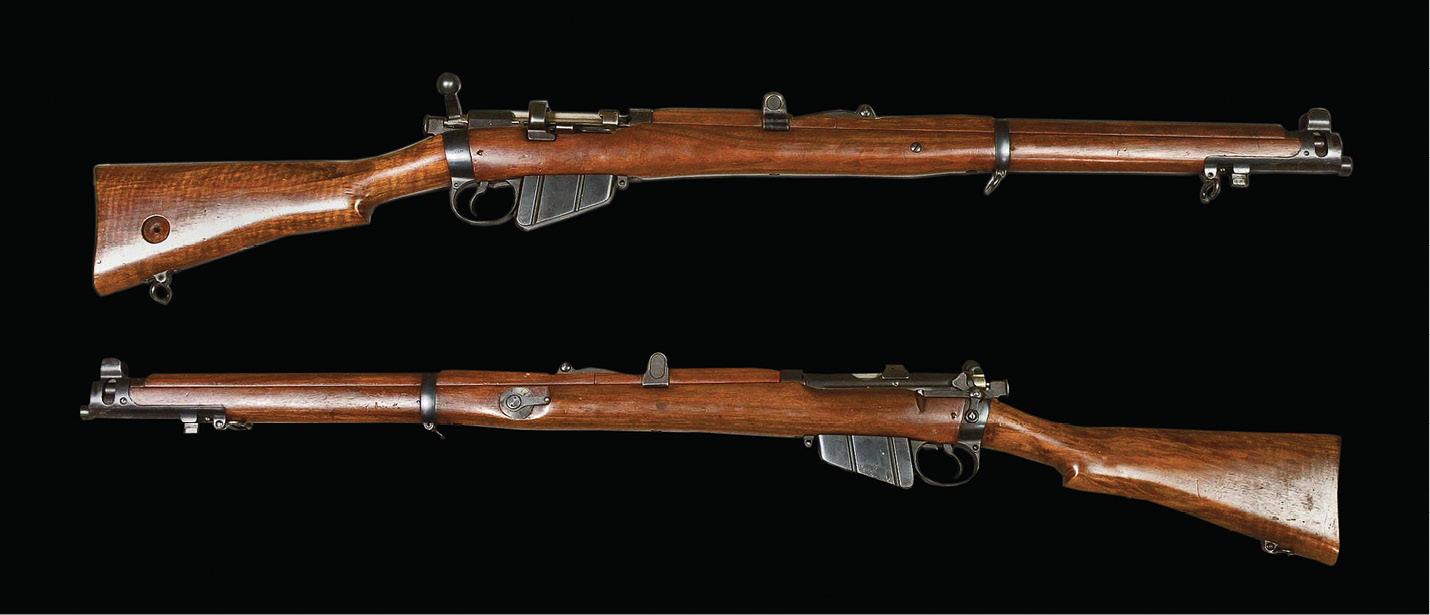28
Short Magazine Lee–Enfield
Country of origin: United Kingdom
Date of manufacture: 1914–18
Location: Armémuseum, Stockholm, Sweden

THE PRINCIPAL WEAPON of the British soldier in the Great War was the Short Magazine Lee–Enfield rifle, SMLE to most soldiers. The SMLE was based on its predecessor, the Magazine Lee–Enfield (MLE) first introduced in 1895. The MLE was the first British service rifle equipped with a ten-round magazine and was famed for its mechanism that cocked the striker when the bolt was closed—a swift action, important in battle, meaning that the weapon could be cocked and fired rapidly. Illustrated is a museum specimen, the SMLE Mark III, preserved in the Swedish Armémuseum and looking as it would have done on issue. Most others that served in the war would be considerably more battered and worn.
The design intention was to build on the reliability of the earlier MLE, but to shorten it, lighten it, and provide the means of its loading through a charger-fed magazine system—thereby capitalizing on its superior bolt action. The resulting rifle, the SMLE Mark 1, was to appear on December 23, 1902. It was 5in shorter than its forerunner (though with three butt sizes fitted to soldiers of differing stature) and was both easier to handle and capable of being used as an infantry rifle and a cavalry carbine.
The charger system used by the SMLE allowed for five rounds to be loaded at a time, the magazine holding ten altogether. In British service, the “charger” was a clip that held five rounds of the standard Mark VII cartridges—known as “ball cartridges.” The charger was discarded when the cartridges were pressed home, forced downward into the spring-loaded magazine that was capable of holding ten rounds in total. The high-capacity magazine and efficient bolt action meant that in the right hands the rifle had an impressive rate of fire. Well-trained soldiers could fire around fifteen aimed bullets per minute with the SMLE—while the record, set in 1914, was thirty-eight bullets fired in a minute, a prodigious rate of fire.
The SMLE was to undergo several modifications through to its last model, the Mark V1, in 1926. It would be one of the most admired bolt-action rifles in history. The early Mark 1 rifles have the provision for a long-range volley sight—inaccurate, but capable in the right hands of putting down a volley with an effective range of 1,500–2,000 yards. The SMLE Mark III, introduced in January 1907 with changes to its sights and charger loading system, was the main rifle to be used during the war; from January 1916, simplifications to this rifle were made in order to speed up production for the New Army.
The British soldier who went to war in August 1914 was one of the best trained in the world. A professional, he was well trained in the musketry drill that was set out in the official manual Musketry Regulations, Part I 1909, which was reprinted in August 1914 in readiness for war. The SMLE was reputed to have one of the fastest bolt actions; it certainly had a larger magazine than the rifles possessed by the Germans, or by their French allies. With this level of training and equipment, the British regular soldier of 1914 could loose fifteen aimed rounds per minute, and sometimes considerably more. In the summer of 1914, with the British Expeditionary Force committed to the field at Mons on August 23, 1914, and engaging in the retreat to the Aisne, the Germans experienced firepower they had not expected. Were they met by machine guns? The simple answer was no.